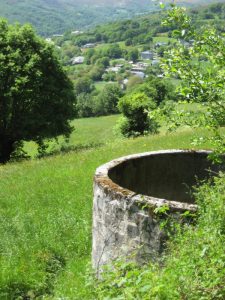Camino of Santiago
 Camino of Santiago: My Quest for the next three weeks
Camino of Santiago: My Quest for the next three weeks
I’m going over to Northern Spain on the 25th to join the Camino trail at Leon and walk in to the cathedral with my good friend Bob Carrothers from Denver.
IF YOU’D LIKE TO BE TUNED IN TO MY DISPATCHES AS I GO, HIT REPLY AND WE’LL PUT YOU ON THE LIST OF RECIPIENTS…
Origins: The Camino was a catholic punishment and purification rite – a penance. In middle ages, the church was the only transnational corporation. It wielded exceptional power over its adherents – everyone.
Towns were worlds unto themselves except for the church. But it wasn’t hard to imagine that a person would most commonly have spent their entire life within a few miles of home. The lord might travel and others if required in military service to him. There might be some movement, but otherwise, unless in a special case, not. And travel was not so freely undertaken. The woods were thought to be full of perils – animal, human and mythic.
There were 3 Catholic pilgrimages in that time: Rome, Jerusalem and Santiago de Compostella. Santiago was where the bones of St. James were disinterred having been mysteriously carried to this town in the part of Spain that reaches the western Atlantic above Portugal.
Committing a truly grievous sin might lead to excommunication by the local priest. That meant more than being cut off from the ministry and prospect of salvation through the church. That soul was persona non grata in their community. No one would relate to or help or transact with the excluded. It didn’t take too long before the communicant was on his knees in front of the priest.
There he would be sentenced. One option was “a Compostella”. The penitent immediately left his town and by a network of trails converging from towns all over Europe southwestward – would walk all the way over the Pyrenees across northern Spain to Santiago. If they got there, they would receive blessings in the cathedral and then return rehabilitated. This is the ancient trail we walk today.
Routes: The conventional route [the Camino Frances] begins at St. Jean Pied-de-Port on the French side of the Pyrenees, traverses to Pamplona, across the Rioja wine country, to Burgos, over the prairie-like Meseta to Leon, then on over another high reach at O Cebreiro and down through the last province – Galicia – to Santiago. Connecting trails still link this avenue with most major towns and centers in Europe. There are several other routes – one starting further south in France, one along the Bay of Biscay shore, another up from Portugal, several through southern Spain.
The classical route is about 800 kms, 500 miles, walked in day stages from 20 – 30 kms/ day. So it takes 30 – 35 days. We’ll be doing about 20 days’ worth.
The Experience: After a long day’s travel, the pilgrim arrives, produces her credential, [proving that she is an official pilgrim, issued by one of the many national pilgrimage societies – often in country of origin]. Then she is admitted to stay in the refugio or hostel. Most are maintained privately or by the municipality along the way.
The routine? Hearty dinner shared with other pilgrims, sleep in a dorm, and walk another day. Very simple, very pure. And extremely reasonable in cost.
Pilgrims today wear lightweight gear and heft backpacks of 20 – 30 pounds. They display a scallop shell – the identifying mark.
Though encouraged by the church, the Camino is not solely for Catholics. Anyone can go: religious observance is not required. It is, in fact, an ecumenical trek, and brings people from all over the globe. It is certainly spiritual – all these folks walking in nature united in one destination. The culmination for most is the Pilgrim’s Mass in the Cathedral at 11 am every day – a joyous occasion. Some carry on to Finisterre at the last edge of Europe, facing the North Atlantic.
The trek is mainly on trails and byways, local roads, occasionally paralleling a highway for a short period. The countryside is varied, from the mountainous Pyrenees to rolling wine country to flat endless hot plains to Galicia – Celtic country that looks and feels more like Ireland. The hosts are hospitable, understanding and encouraging. The route is self-guiding, there is always a yellow arrow: this way!
Contacts: The Canadian Company of Pilgrims – http://santiago.ca – numerous others
App: Camino Community Guide
Books: The Pilgrimage by Paulo Cuelho, and many more
Movie: The Way starring Martin Sheen.
SO TO TRACK ALONG – HIT REPLY AND WE’LL KEEP YOU IN THE LOOP…
Sincerely,
Doug Bouey
Catalyst Strategic Consultants Ltd.

What’s Our Business?
Doug Bouey, President
Catalyst Strategic Consultants Ltd.
Calgary, AB // Phone: 403.777.1144
Email: boueyd@catalyststrategic.com

Leave a Reply